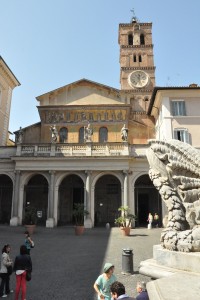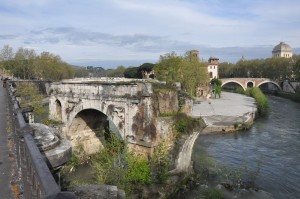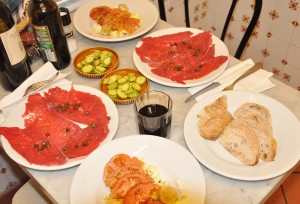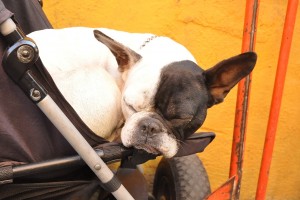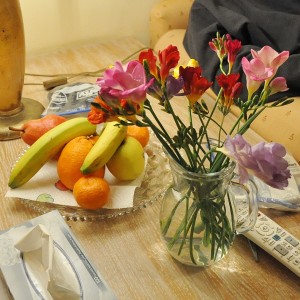When in Rome, we say, live in Trastevere.
It is the quiet place—except perhaps around the fountain in the Piazza di Santa Maria in Trastevere when the young folk are socializing or perhaps along via della Lungaretta, the blocks between busy viale di Trastevere and the aforementioned piazza.
Trastevere—that place “across the Tiber”—has its own hill not counted among Rome’s legendary seven. The Gianicolo (or Janiculum) rises precipitously behind the houses, villas and shops that fill the flood plain of the western bank of the river. Slopes are draped with gardens and heights ornamented with churches, monuments and palazzi. The Gianicolo is steep. Roads double-back in hairpin turns to reach the summit. Here and there scalae grand and small help the pedestrian ascend and descend directly. In truth, though, a taxi is the quickest way to the top; definitely best for us old folks.
Even for three or four nights, an apartment is more spacious and comfortable than any hotel within our budget. For a week-long visit—or a glorious fortnight—at least a part of a strange city becomes known, welcoming after hours of more distant explorations; the neighbors become friendly if not friends.
Our corner, where via dei Salumi meets via della Luce, is perhaps three or four minutes stroll from a forceful bend in the Tiber and the three bridges that take us into the Rome of the Seven Hills: the northernmost of the three, the Ponte Garibaldi; the Ponte Cestio bringing us across the Isola Tiberina and into the Porta d’Ottavia and the Old Jewish Quarter; and the Ponte Palatino which ends in the Piazza Bocca della Verità where the relic of Roman paganism in the entrance to Santa Maria in Cosmedin is reputed to bite the hand of the liar who extends it. Most everywhere is within walking distance—but the no. 8 tram runs us straight to Piazza Venezia, the H bus gets us to Termini Railroad Station, and bus 280 takes us up and down the Lungotevere on both banks, north to stops for the Vatican and the Piazza del Popolo, south to Piramide, the Ostiense Station, and the Cimitero Acattolico where we can visit the poets John Keats, Percy Bysshe Shelley and Gregory Corso.
Our neighborhood is an accepting place. Only once have I not seen the bundle of red and orange, the blanketed form of a homeless person who makes his home in the Piazza Gioacchino Belli, sleeping on the bench of the monument to that Roman poet. Once or twice he shifted base to the seating below the trees, further from the street. I assume that he is a he; a glimpse of a muscular shoulder, the feet that occasionally are uncovered suggest it to me, anyway. 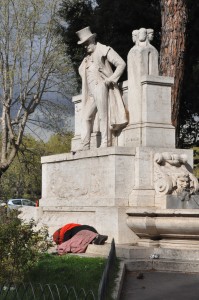
Every morning the market bustles in the Piazza San Cosimato. Rome is not a city of early risers. At eight, few shops are open except for the pasticcerias offering coffee and a sweet roll to those on way to work or school. But I take my bright red handle-sack and collect what I need for dinner. My favorite salumeri e formaggio is on San Francesco a Ripa. We buy their olives from Gaeta, Bastardo del Grappa cheese from the Veneto, carciofi marinated in olive oil. There is also a very good cheese stall in the Piazza San Cosimato. The best macellaio is also on San Francesco, but on the other side of the viale di Trastevere. You should see that man cut unimaginably thin slices of beef for the carpaccio I will dress with olive oil and capers. Right next to the macellai is the enoteca with the best stock of wines and spirits. I tried several but one from the shelf marked Toscano was the best.
But around the corner is the forno with the flat crusty rolls, perfect for pannini or bruschetta. They also have the apple strudel that my Dear One likes for breakfast, so I stop in there. The older woman behind the counter is brusque with me for a while; by the time we leave, she smiles when she sees me waiting to order. Best of all is Jackie’s store. I don’t really know what it is called, but it is our frutteria, the place to get fruits and vegetables, and the largest, sweetest, purplest blood oranges I have ever tasted. Jackie is the store dog, a French bulldog with her own stroller and a disposition all sweetness and light. She smiles at me too, but she never scowled, not even once.
There is nothing we cannot find in our neighborhood in Trastevere. I needed a needle and thread, and found a little dry goods shop behind the cheese and meat stalls in the Piazza. An adaptor that allowed the computer’s three-pronged plug to go into an Italian outlet was at the shop on Via Natale del Grande; he also provided an electrical cord for the iPod player, as we had forgotten to bring ours. The young man at the flower stall sold me my handful of posies for 3 € and some spare change because I didn’t have 4 € or anything smaller than a twenty.
Gelato? The Caffe San Cosimato is very good. Dinner? Ristorante San Cosimato (a different business just across the street) serves dinner relatively early. There are, of course, innumerable eateries and purveyors of foodstuffs all around us. We could have eaten at a different place every day without walking more than ten minutes. Clothes, household furnishings, jewelry, accessories, postcards, and souvenirs? All right here.
Our apartment at 29A via dei Salumi is an eccentric little space carved out of the ground floor of an ancient structure; vaulting in the high ceilings and the remains of an archway in the wall that separates bedroom from living room hint at its past. A few steps up lead to a diminutive kitchen with a more than decent-sized refrigerator and a washing machine lurking in a corner. A couple steps down go to the large bedroom and bathroom—and the bathroom has plenty of hot water although the shower may be the smallest I have ever wedged myself into. The owner of Apartment Conti, Carla Conti, welcomed us with a charger laden with fruit and a homemade sponge cake. Please, get in touch with her. Tell her I said to write.
The gods have been kind. The weather is vernally beautiful; one thunderstorm at night, one shower during dinner, skies more often blue than not.
More wine? Why, yes, please. Oh, and a plate with a slice of orange, a piece of the Bastardo and a handful of olives, thank you so much. I have finished Robert Hughes’ Rome but there is so much more I need to read. And I am so comfortable here in my home in Trastevere.

